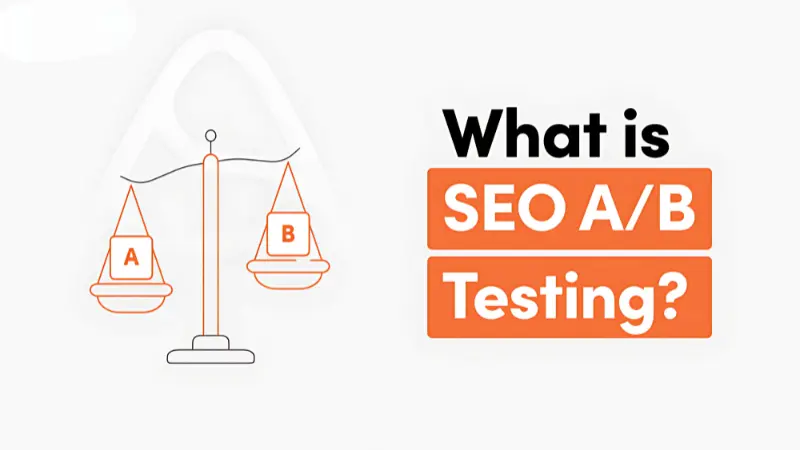What is SEO A/B Testing?
SEO A/B testing (also called split testing) is a method used to experiment with different SEO strategies to determine which version of a web page performs better in search engine rankings and user engagement. By testing small changes—such as title tags, meta descriptions, internal links, and content structure—you can make data-driven decisions to improve your website’s performance.
Unlike traditional A/B testing (which focuses on user interactions), SEO A/B testing is search-engine-focused and helps identify ranking improvements based on algorithm preferences.

Why is SEO A/B Testing Important?
Improves Click-Through Rate (CTR): Optimized titles and meta descriptions can increase organic CTR.
Boosts Rankings: Testing content variations can help identify what Google favors.
Enhances User Engagement: Analyzing which version retains visitors longer.
Data-Driven Decision Making: Avoids guesswork by relying on real search data.
Reduces Risk: Instead of making large-scale changes, you can test small variations before applying them site-wide.
What Elements Can You A/B Test for SEO?
Title Tags & Meta Descriptions
Example: Testing “Best SEO Strategies for 2025” vs. “2025’s Top SEO Strategies That Actually Work”
Headings (H1, H2, etc.)
Example: “How to Rank Higher on Google” vs. “The Ultimate Guide to Google Rankings”
Internal Linking Strategies
Testing the placement and number of internal links.
Content-Length & Format
Shorter vs. longer content, bullet points vs. paragraphs.
Schema Markup Implementation
Testing rich snippets like FAQs and review schema.
Page Load Speed Optimization
Testing compressed images, lazy loading, and CDN integrations.
URL Structure & Slug Optimization
Example: “website.com/best-seo-practices” vs. “website.com/seo-guide-2025”
Image Alt Text & Multimedia Enhancements
Testing different image descriptions and video placements.
Best Tools for SEO A/B Testing in 2025
Google Search Console (to track ranking changes)
Google Optimize (for split testing elements)
ClickFlow (SEO-focused A/B testing tool)
SplitSignal by Semrush (SEO test automation)
Google Analytics 4 (to monitor user behavior and conversions
How to Run an SEO A/B Test (Step-by-Step Guide)
Step 1: Identify What You Want to Test
Pick an element that directly impacts rankings or engagement (e.g., title, meta description, content structure).
Step 2: Select a Control & Variant Page
Control Page: The current page version.
Variant Page: The new version with changes.
Step 3: Set Up & Implement the Test
Make the changes to the variant page using an SEO A/B testing tool.
Ensure that both pages target the same keywords and audience.
Step 4: Track & Monitor Results
Use Google Search Console & ClickFlow to track rankings, CTR, and organic traffic.
Monitor bounce rates, dwell time, and conversions in Google Analytics.
Step 5: Analyze & Apply the Best Performing Version
If the variant outperforms the control page, apply the change site-wide.
If the test fails, adjust and test again with new variables.
Common SEO A/B Testing Mistakes to Avoid
Testing Too Many Elements at Once – Keep it simple and isolate one change per test.
Not Running Tests Long Enough – Allow at least 4-6 weeks to gather meaningful data.
Ignoring External Factors – Algorithm updates, seasonality, or competitor changes can skew results.
Using Small Sample Sizes – Ensure tests have enough impressions for statistically significant results.
Forgetting User Behavior – SEO is about both rankings and user engagement; analyze both.
Real-Life Case Studies of SEO A/B Testing Success
Case Study 1: Increasing CTR with Title Optimization
A website tested two title variations:
Control: “Best Digital Marketing Tips for 2025”
Variant: “2025’s Most Effective Digital Marketing Strategies (Proven)”
Result: The variant title increased CTR by 37%, leading to higher rankings.
Case Study 2: Improving Rankings with Content-Length Adjustments
A travel blog tested the length of its blog posts:
Control: 800-word articles
Variant: 2,000-word in-depth guides
Result: The longer content received 56% more organic traffic and higher engagement.
Case Study 3: Boosting Internal Link Impact
An e-commerce site tested internal link placements:
Control: Links only in the footer
Variant: Links placed within product descriptions and blog content
Result: The variant saw a 22% increase in conversion rates and improved category page rankings.
FAQs About SEO A/B Testing
1. How long should an SEO A/B test run?
Ideally, 4-6 weeks to gather statistically significant data.
2. What’s the best tool for SEO A/B testing?
Tools like Google Optimize, ClickFlow, and SplitSignal are great for SEO split testing.
3. Can I A/B test content length?
Yes! Testing longer vs. shorter content helps determine which format ranks better.
4. Does A/B testing affect SEO negatively?
No, if done correctly. Google allows controlled experiments as long as they are temporary and well-documented.
5. How do I measure A/B test success?
Monitor rankings, CTR, bounce rate, and conversions to see which version performs better.
Final Thoughts: How to Continuously Optimize Using SEO Experiments
SEO A/B testing is a powerful strategy that allows you to experiment and find what works best for your website. Instead of relying on guesswork, testing allows for data-driven decisions that enhance rankings, CTR, and conversions.
Want to implement SEO A/B testing but don’t know where to start? CG Marketing offers expert SEO testing strategies to help boost your search rankings!
